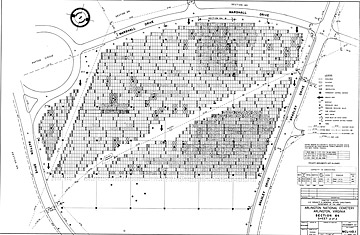
Arlington National Cemetery, Section 64
Many large modern cemeteries store data on the identity of remains via computer and keep track of grave locations with the aid of satellites. The previous leadership at the cemetery blew unknown millions trying to develop a similar system, but ended up just handing money to favored contractors who did little in return, according to an Army investigation last summer. As a result, Arlington tries to keep track of around 30 burials a day on pieces of paper.
Arlington is carved up into 70 sections, often containing several thousand graves each. Graves are typically numbered sequentially in each section. Three pieces of paper help Arlington officials keep track of the location and identity of remains in those sections. It is that paperwork that is seriously flawed.

The first two pieces of paper, called a grave card (above) and an interment record (below), show the basic information on each deceased person at Arlington like the name, military rank, date of death, date of burial, and grave number.

Sometimes, those two documents conflict, essentially showing that one person is buried in two places. For example, the grave card for Army Maj. Louis Lopez says he is buried in section 60 in grave number 1618. But Lopez' interment record says he is in grave 7618.
In still other cases, burial paperwork occasionally shows two unrelated service members both buried in the same grave. (In late 2009, I wrote a piece in Salon.com about a case where the cemetery had, in fact, mistakenly buried two service members in the same grave, one on top of the other).

The internal cemetery burial maps are the other pieces of paper that help officials keep track of the locations of remains. Each map portrays a section of the cemetery. Each grave in that section is drawn on the map as a tiny box with a number in it, the grave number.
On the map, occupied graves are shaded grey. Empty graves are blank. Graves that can't be used because they are obstructed by, say, tree roots or a water pipe are marked with an X.
The maps are atrocious. Just walking around the cemetery with a map (the cemetery doesn't hand them out, but TIME has many) and you can see problems with the naked eye. There are many, many spots where, on the map, the little boxes of graves are shaded grey — occupied — but out in the cemetery, there are gaps between headstones where there is nothing there but open grass. The cemetery says these are likely just map problems and nobody is buried in those empty spots. But without a backhoe or at least ground-penetrating radar, there is no way to know for sure if the map is wrong or the headstones are missing. The new chief at Arlington, Kathryn Condon, now says she is disinclined to use a backhoe to be sure.
Award-winning journalist Mark Benjamin first broke the Arlington scandal in 2009 writing for Salon.com.
